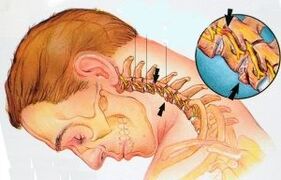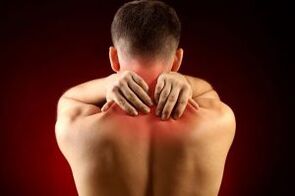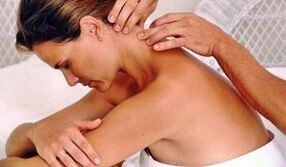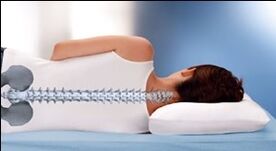
In the question: How to treat the cervical back osteochondrosis, there is one answer: to affect the cause of this disease yourself if you are not an acute period.
Medicine treats the investigation - the symptoms of the disease, not the cause.Therefore, do not hope for doctors, do not throw money in ointments, teas, injections, physiotherapy, simulators, massage.None of the funds listed will help you.
So it is categorically to say that my personal experience in treating cervical osteochondrosis, which I will be happy to share in the hope that it will help one of you cope with this problem.
However, success in treatment will depend on some conditions:
- Your desire to help yourself;
- willingness to understand the true cause of cervical osteochondrosis;
- Compliance with itself -the most strict discipline in treatment.
What do you need to know about cervical back osteochondrosis
To answer the question:How to treat osteochondrosis of the cervical spine,It is necessary to understand the cause of the disease well.To understand it, you will need to be directed to the anatomy of the spine.
Our back is a strong but flexible case for vital blood vessels and nerve underwear.Supporting the spine in good condition means not having health problems.
But we, out of ignorance or because of a frivolous attitude towards health from a young age, treat the spine carelessly: load excessively, we get unpleasant poses, sitting for hours on the computer or table during sitting work, we spend a lot of time running a car in a tense state, we have an inaccurate position, etc.

The cervical spine is more mobile.It consists of seven beads, among which there are intervertebral elastic discs.They are clearly visible in the figure.The discs make the spine flexible and at the same time give it strength.
Each intervertebral disc consists of a fibrous ring, within which there is a pulp nucleus.
At the cervical spine, the cerebrospinal nerve and vertebral arteries pass, which, through the branched nerves and blood vessels, feed not only the head along with the brain but also the organs of the shoulder band.
Cervical osteochondrosis is changes in the intervertebral discs of the cervical spine as a result of physical, inflammatory or mental exposure.The elasticity and strength of the intervertebral discs decreases, while their height also decreases.
In the future, if you do not treat the disease, the fibrous ring of the intervertebral disc is squeezed and deformed, which can lead to extension.In more severe cases, the fibrous ring of the disk breaks down, and the pulpica core lasts in the form of a hernia, while squeezing the nerve endings coming out of the vertebral holes, as shown in the figure.
Thus, the cause of cervical osteochondrosis is a change in intervertebral discs in the cervical spine against the backdrop of weak muscles.Moreover, even a slight muscle tension can lead to a displacement of the vertebrae, as a result of which nerve endings end, and the pain occurs.
But there are many factors, as a result of which there is a change in discs.It is a sedentary lifestyle, and a hereditary predisposition, metabolic disorders, and injuries, and the deposition of salts on the cervical spine and others.
How does cervical osteochondrosis manifest?All symptoms indicate that as a result of changes to the intervertebral discs, intrigue and blood supply to the brain, head, neck and shoulder band are damaged.Therefore, the symptoms of cervical osteochondrosis are headaches in the back of the head and temples, Dizziness with a sharp twist of the head, noise in the ear, a decrease in visual acuity, hearing deterioration, neck pain, shoulders, shoulder blades, hands and sometimes in the heart.
Dizziness with a sharp twist of the head, noise in the ear, a decrease in visual acuity, hearing deterioration, neck pain, shoulders, shoulder blades, hands and sometimes in the heart.
If the cervical osteochondrosis is not treated, then due to impaired cerebral circulation, diseases such as: migraine, hypertension, vegetable dystonia, hearing problems, eyes, coordination, with cardiovascular and respiratory systems.In advanced cases, brain ischemia and stroke can develop.
Personal experience in treating cervical osteochondrosis
The diagnosis is cervical osteochondrosis, gave me a neuropathologist at the age of 45.After looking at the X-ray photo of my neck, he wrote on the card near the diagnosis: the height of the discs between the C5-C6 and C6-C7 vertebrae was significantly reduced.I tried by frequent headaches, ringing in my ears, neck pain.
The question arose:How to treat cervical back osteochondrosis.The doctor calmly "assured me" that osteochondrosis is impossible to fully cure, as the intervertebral discs were deformed.He described me not free, with those prices, oil, and advised me to sit directly on the table.It was the 90s, I bought the oil according to the recipe for a neuropathologist at some leftist pharmacies.But the relief oil did not bring, the pain poisoned my life.
At the recommendation of acquaintances, I addressed the services of a paid specialist in manual therapy with higher medical education.After he, after feeling the cervical beads, turned my head, seemed to be 180 degrees, became light, illuminated and not painful.However, the procedure was clearly dangerous.The manoalist warned that for three days you should sit directly on the table, and not in a favorite position.

I followed the recommendations for two days, and then I forgot them.A few days later, my condition again became the same as before I visited a doctor - a manualist.This experience told me how to treat osteochondrosis of the cervical back.Once the young -I read all the literature on osteochondrosis, I realized that I had to affect the disease independently.Doctors here are not assistants.It is impossible to change the disk deformation, but you can stretch the cervical pole, and thereby reduce the pressure on the nerve endings and blood vessels.
At home we always had a horizontal bar, in the morning, hanging on it, you get a good stretch of the entire spine except the neck.I have tried many ways to extend my neck and developed my system for the treatment of cervical osteochondrosis:
- Changed her behavior.It was not easy and it did not happen immediately, but myself -Discipline and motivation helped me feel healthy.I often looked in the mirror in my behavior, controlled it, going close to the wall: my head should touch the wall, that is, to be in the same line with the heel.I always try to hold my head and shoulders straight.Today, when I am 60, I have a better attitude than it was twenty years ago.
- Every morning and evening I do "turtle" exercise from the Tao revitalization system.Sometimes I do it more often if I feel tension or hesitation in the neck, upper spine or shoulders.Make the turtle to the turtle sitting as in the figure:
- Lower your chin to the chest, pulling your head up with your head.Inhale slowly.At this time, the back of the neck extends up and the shoulders fall down;
- Slowly pull out, take the back of your head down, as if you want to touch them at the back of the neck.The doctor lies up, the throat extends slightly.Shoulders rise to both sides of the head, as if they are ready to touch the ears;
- Repeat this cycle 10-12 times, trying to do everything slowly.
Turtle exercise contributes to the safe stretch of the cervical spine, strengthens the neck and shoulder muscles, eliminates fatigue, stiffness and pain, improves metabolism and renews the body.
- In addition to the "tortoise" I do a drill to relax the entire shoulder band, also sitting:
- Raise and lower your shoulders 10 times;Tilt the head slowly to the left - to the right 10 times on each shoulder;
- Tilt the head slowly forward - back 10 times;
- Tilt the head first to the right (right ear on the right shoulder), then slowly, stretching the neck and throwing the head, rolls on the left spine and shoulder.Then from the left shoulder - to the right.Make 10 sheets on each shoulder;
- Relax, direct the spine again, balance the body weight on the tail pole, and start to slowly make circular movements with a peat from left to right, then 10 times from right to left.At the same time, head, shoulders, hands are calm in rotation.
This exercise, in addition to relaxation, awakens the body's healing forces, normalizing the energy of all cells and organs.
- When working on the computer for a long time, I put a neck collar (it can be bought at a pharmacy).I'm not sitting in it for a long time, an hour or two.It allows you to keep your head straight.
- If I have noticed that from a difficult position, for example, sitting next to the TV or working on the spot, I had a bell on my ears or headache, immediately rest (as read here), after which I have the exercise of the turtle.Call and pain spend within 5-10 minutes.

Relaxation and extension of the neck and shoulder band should become part of your daily life, then you will feel good, having a diagnosis such as cervical osteochondrosis.
Before starting the exercises, consult your doctor.
Here I want to note that such treatment of the disease is possible out of irritation.If you have an acute period of cervical osteochondrosis with nerve disorders by hypothermia or any infection, then see a doctor and get the prescribed blockade, injections, etc.Once the irritation passes, you can apply my method.
You are also a note: you can relax the neck muscles by taking a hot shower in the neck or getting caught in the bathroom.
Run a removable lifestyle, but avoid the sharp curves of the scalp, the heavy burden, as the shoulder muscles are tense, the spasm of which will move the beads and violate the roots of the nerves and blood vessels in the neck.
Sleep in a small pillow, often in the fresh air, change negative thoughts in positive so that your stresses do not strain the cervical and shoulder areas and to exacerbate the symptoms of osteochondrosis.

Respect the right food.Exclude sugar and white bread, oven products from your diet.Eat more vegetables, fruits and grains.
Now, I hope to figure out how to treat the cervical back osteochondrosis.
Believe yourself and live painlessly with your cervical osteochondrosis!






















